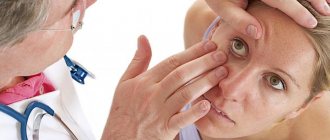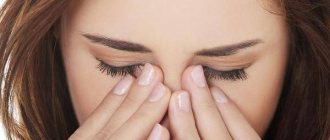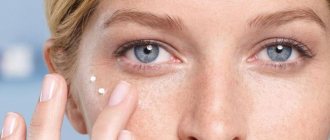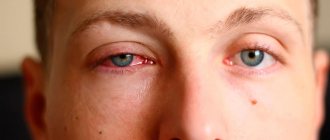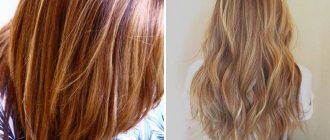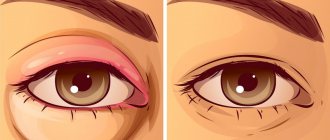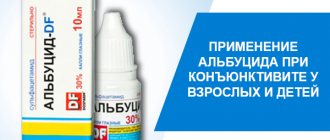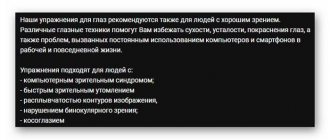Causes of eye fatigue
Ophthalmologists say that genetic predisposition plays a huge role in the development of eye diseases. Myopia is inherited in half of cases. Those who have relatives with eye disease should especially take care of their eyesight.
You need to pay attention to the first symptoms of eye disease and, if necessary, contact an ophthalmologist.
Eye fatigue is a borderline condition that can lead to more serious eye pathology if not treated promptly. In medical practice, chronic eye fatigue syndrome is called asthenopia.
The cause of asthenopia can be completely different factors:
- Long-term reading of books (more than 4 hours a day).
- Improper use of the computer and work with small parts. After 45 minutes there should be a five-minute break;
- Incorrect room lighting. Both a lack of light and an excess of it have a bad effect on the organs of vision. Eyes get tired quickly. Incorrect placement of light sources also has a negative effect. The best option is natural light lamps. Their light is soft and does not hurt the eyes. The table should always be placed opposite the window.
- The air humidity in the room must be normal. If air humidity is low, dry eye syndrome occurs.
- Incorrectly selected optics to correct decreased visual acuity. This reason can be solved; you just need to visit an ophthalmologist.
- Migraines, headaches, spinal osteochondrosis.
- Arterial hypertension.
- Poor nutrition. We are talking about a lack of vitamins (A, C, PP, B) and microelements (calcium and potassium) in the diet, which have a beneficial effect on the visual system.
- Bad habits (smoking and drinking alcohol).
Remember! You cannot read while traffic is moving.
Diagnosis and treatment
If there are complaints of visual fatigue, the ophthalmologist conducts a visual acuity examination, both with and without correction. Visual acuity is checked with a relaxed ciliary muscle (in a state of cycloplegia), which is achieved by instilling special drops (mydriatics).
If the examination results in farsightedness, presbyopia, or astigmatism, then the next stage of treatment will be the correction of these disorders using glasses or contact lenses.
Means for correcting refractive errors with concomitant asthenopia should be prescribed as early as possible. The issue of the correct regime of visual stress, organization of the workplace, provision of regular breaks at work and general strengthening measures must also be resolved as early as possible.
Glasses are recommended for children to wear constantly. Adults are prescribed glasses for reading and working at close range, provided there is sufficient distance visual acuity.
Hardware treatment methods play an important role in eliminating complaints. Our clinic has a wide range of devices to eliminate all symptoms of the disease and improve vision. More details >
Symptoms of eye fatigue
The presence of asthenopia can be manifested by the following symptoms:
- eye pain or headache;
- a feeling of sand or a foreign body in the eyes;
- dry eyes or watery eyes;
- decreased visual acuity;
- redness of the whites of the eyes and dilation of blood vessels in the mucous membranes of the eyes;
- bruises, swelling and dark circles under the eyes, a feeling of heaviness in the eyelids;
- double vision or distortion of visible objects;
- the appearance of dots, spots, and blurred vision;
- a feeling of heaviness, pain, a feeling of the eye widening from the inside;
- difficulty moving the eyes.
Symptoms
Asthenopia manifests itself with ocular and visual symptoms:
- a veil before the eyes;
- blurring and doubling of objects;
- the shape and size of images are distorted;
- eyes become inflamed;
- the production of tear secretion increases;
- there is a feeling of fatigue in the eyes, a feeling of increasing their temperature;
- discomfort, pain, pain and burning appear.
In this case, headaches and increased irritability often occur. Blepharitis or conjunctivitis often develops against this background.
There are several stages in the clinical course of asthenopia:
- Compensation.
- Subcompensations.
- Decompensation.
At the first stage, the patient experiences a short-term disturbance in visual function, which remains within normal limits. Because of this, a compensated form of eye fatigue is visual discomfort, which appears after strain on the eyes and a short rest. At this stage, a person may experience a burning sensation, increased production of tear secretion, redness, and blurred vision.
The second stage involves long-term visual impairment that is potentially reversible. At this stage, there may be a feeling of sand and pain in the eyes. The image may appear double or distorted. It is important to note that functional vision disorders can manifest themselves 1-2 days after rest, and appear even after a slight load.
How to give your eyes a rest?
To prevent and treat eye strain syndrome, medications, folk remedies, gymnastics and eye massage, and special glasses for working on a computer are used.
Medicines
Medicines are prescribed by an ophthalmologist. They are used for the chronic course of the syndrome in the form of eye drops and tablets. Sometimes a person needs treatment for concomitant diseases. Medicines used in the form of eye drops are divided into three groups:
- Moisturizing medications. Used in the treatment of dry eye syndrome - “Systane”, “Systane-ultra”, “Allergodil”, “Natural Tear”, “Oxial”, “Hilozar”. The products have a similar composition to tear fluid. They are used for both therapeutic and prophylactic purposes.
- Vasoconstrictor medications. Used for redness and swelling of the eyes - “Vizin”, “Visoptik”.
- Vitamins for the eyes. Used to improve vision and improve performance - “Pro-Visio”, “Allergodil”, “Quinax”, “Riboflamin-mononucleatide”, “Lutein-complex”.
The tablets contain drugs with a general strengthening effect, vitamins and microelements. For example, “Optics”, “Blueberry-forte”.
Remember! Before using medications, you should consult an ophthalmologist.
Folk remedies
Folk remedies are widely used to relieve eye fatigue. They are used in the form of lotions and compresses.
Remember! You cannot put a product that is not a drug into the eye.
- Mallow petals are soaked in cold milk and applied to the lower eyelid for 10 minutes 3-5 times a day. Then you can wash your face with cold water.
- One teaspoon of dill seeds is poured into 100 ml of boiling water. Leave for 30 minutes. Half of the solution needs to be cooled. Apply lotions to the eyes with warm, then cold infusion. You can repeat it 5 times a day.
- Pour one teaspoon of chamomile into 100 ml of boiling water. Let it sit for 30 minutes, make a lotion and apply it to the eyes for 10 minutes, apply it 3-5 times a day.
- Rosehip decoction is prepared and used like chamomile decoction.
- Easy to use tea bags, best with green tea (lots of nutrients), apply for 5-10 minutes 5 times a day.
- Boil one tablespoon of millet for 10–15 minutes. Let it brew for 2 hours, strain and let cool. Prepare compresses and apply to eyes 3-5 times a day for 10 minutes.
- Pour one teaspoon of cornflower flowers into 100 ml of boiling water, leave for 30 minutes and prepare the lotions. We apply them to the eyes 5-8 times a day for 10 minutes. Helps well with conjunctivitis of the eyes.
- The cucumber is cut into circles and applied to the eyes. The procedure lasts 10 minutes. Cucumber also tightens the skin and removes bags under the eyes. Can be used up to 8 times a day.
- Raw potatoes are cut into circles, but it is better to grate them, which releases starch (removes puffiness under the eyes). Apply to eyelids for 10 minutes. The procedure can be repeated up to 8 times a day.
Causes of tired eye syndrome
The causes of tired eye syndrome can be varied. However, most often the symptoms of this disease are caused by overload of the organ of vision , including: prolonged use of a computer, tablet and smartphone. Electronic devices of this kind are a common cause of vision defects, since their use reduces the blinking rate .
Other causes of dry eye syndrome include: prolonged reading, long car trips, and unfavorable environmental conditions (primarily air pollution).
Sometimes tired eye syndrome can accompany hormonal changes , including menopause and the associated decrease in estrogen levels, primary hypothyroidism and thyrotoxicosis.
In turn, factors that increase the risk of developing tired eye syndrome include:
- age over 40 years - in people who have crossed this age barrier, a gradual process of atrophy of the lacrimal organs occurs
- wearing contact lenses that causes excessive dry eyes
- deficiency of vitamin A and omega-3 and omega-6 fatty acids
- staying in air-conditioned rooms
- pregnancy and associated hormonal changes
- chronic stress
- facial nerve irritation
- autoimmune diseases, including arthritis, erythema multiforme, biliary cirrhosis and muscle inflammation
Prevention of asthenopia
Prevention regarding asthenopia is important. In order to avoid this pathology, you need to follow basic rules:
- working on a computer and reading books in proper lighting, and the humidity in the room should be normal;
- correct regime of eye strain and rest;
- timely qualified diagnosis and treatment of the visual organs;
- modern correction of decreased visual acuity (correct selection of glasses and lenses);
- systematically correct performance of eye gymnastics;
- vitamin therapy for the eyes;
- complete balanced nutrition;
- lead a healthy lifestyle;
- regularly visit an ophthalmologist and follow his recommendations; It is recommended to visit a doctor once a year.
If a person follows all the recommendations of the ophthalmologist and carries out prevention, asthenopia can almost always be cured.
Remember! It is necessary to contact an ophthalmologist in a timely manner.
Key rules for eye care
Every person should take care of their eyes, observe hygiene rules, rest and work schedules, limit time spent on the computer, mobile phone and tablet, lead a healthy lifestyle, follow proper nutrition standards, regularly visit an ophthalmologist and follow his recommendations.
Manifestations of asthenopia
Signs of asthenopia or visual fatigue are varied. The main ones are: pain, feeling of sand and a foreign body in the eyes, rapid fatigue, double vision, blurred vision, headaches, lacrimation. All of them, in combination or separately, appear during visual work, primarily appearing in the eyes.
Visual stress that causes asthenopia is also varied: visual fatigue is caused by working at close range - at a computer monitor, as well as reading, sewing, driving at night, and more.
Tea bags
Tea has anti-inflammatory and tanning properties.
It eliminates the infectious focus, so swelling and inflammation go away. To use the method, you need to pour boiling water over the tea bags and wait until they cool completely. They can then be placed on the eyes as a lotion or used as a liquid in which cotton pads are dipped.
Exercises and application of the rules are considered highly effective if a person experiences eye fatigue due to severe stress. If a patient has a systemic disease, it is necessary to treat it first, and then resort to therapeutic and preventive measures. When following all recommendations, it is important not to harm human health and strictly follow the instructions.
Gymnastics for the eyes
Don’t forget about such a proven remedy for eye fatigue as gymnastics. To do this, it is enough to make circular movements with your eyes or movements left-right and up-down. In addition, when working at a computer, you need to give your eyes a rest at least once an hour and take a break from the monitor for five to ten minutes.
If you have severe vision problems, then it is unlikely that the above methods will help you solve them. It is better to contact a qualified specialist who will make the correct diagnosis and prescribe appropriate medication.
How to deal with fatigue? Basic methods
It is necessary to take care of prevention. It includes regular breaks when working at the computer, special exercises and vision correctors. Medicines are selected for chronic fatigue. Typically, local medications are used for these purposes, such as eye drops or ointments, which are divided into several groups:
- Moisturizing compositions . They compensate for dry mucous membranes and are suitable for the prevention and treatment of dry eye syndrome.
- Vasoconstrictor compounds . Eliminate redness and tissue swelling.
- Vitamins . Improve vision, enhance the performance of the visual organs. If your eyes get tired quickly, they may be lacking useful microelements.
The duration of treatment for eye fatigue depends on how severe the symptoms are and what stage of development the pathology is at. Therapy includes several areas at once.
Eye drops
The main medications to combat fatigue and discomfort are eye drops. They improve the condition of the mucous membrane during tension, reduce dryness and burning that appears at the end of the day. They can be used when wearing contact lenses.
A good option would be Gilan eye drops. The drug does not contain preservatives; it contains hyaluronic acid, which saturates the cornea with moisture and micronutrients. The drops relieve fatigue, help fight dryness and redness, and reduce pain and burning. When used regularly, they protect the mucous membrane from drying out. Suitable for children, pregnant women.
Before using drops, you must make sure there are no contraindications!
Gymnastics to prevent eye strain
Therapy may include exercises that relieve tension, reduce discomfort and fatigue, and relieve dry mucous membranes:
- Make circular movements with your eyes regularly, first 10 times in one direction, then 10 in the other.
- Keeping your head still, look to the left as much as possible, then in front of you, then move your gaze to the right. This needs to be done slowly, calmly. The exercise can be alternated with moving the eyes up and down.
- Squeeze and relax your eyelids 20 times, tensing your eye muscles.
- Blink about 50 times quickly to increase tear production.
- Place the paper on the window. Then, approaching the glass, focus your gaze on it, and then transfer it to an object in the distance.
- Massage your eyebrows with your index and ring fingers, placed at the beginning and end of the eyebrow arch.
- Don't forget exercises to warm up the upper shoulder girdle and neck: twists, bends or rotations.
Immediately after gymnastics, place tea bags or cotton wool soaked in a decoction of medicinal plants on your eyelids.
Eye masks for fatigue
Cooling gel masks for eye strain are an excellent choice. They are stored in the freezer and taken out at the right time to apply to the area around the eyelids. Thanks to the effects of cold, swelling is reduced, the skin is tightened and smoothed. In case of severe fatigue, the gel mask has a refreshing and invigorating effect and reduces stress on the visual organs.
An alternative to masks is a cooling cream. It affects the skin around the eyes, reduces the feeling of fatigue. This is a temporary help that only removes the symptoms, but does not eliminate the cause of the discomfort!
Fatigue glasses
Modern optics with special coating are great for working at a computer. It acts as a light filter, helps to distinguish colors more clearly, and enhances visual acuity. Thanks to this, reading from the monitor screen becomes more comfortable and your eyes get less tired.
To select suitable glasses, you should consult an ophthalmologist, who will evaluate the patient's vision. He will determine concomitant diseases, a tendency to farsightedness or myopia, and identify why the eyes get tired. Based on the results of the examination, the doctor will write a prescription, according to which you can order suitable glasses from the optician.
Folk remedies
Folk remedies are suitable for home treatment. They can be used as a complement to primary therapy after consultation with a doctor.
The simplest recipe is used tea bags that can be applied to the eyelids. Green tea is best suited for these purposes, as it contains the most nutritional components.
Let us note a few more effective recipes that can be used at home.
Propolis on water
Propolis has a pronounced anti-inflammatory effect. To treat eye fatigue, an aqueous solution of propolis is used, which should be instilled onto the mucous membrane.
Chamomile compresses
Pharmacies sell ready-made bags of chamomile flowers. Brew two bags in 250 ml of boiling water and leave for a while. Cotton pads are moistened in the prepared decoction and applied to the eyes for 20 minutes. Chamomile has anti-inflammatory properties, so it will be useful not only for eye fatigue, but also for certain diseases. For example, with conjunctivitis.
Cornflower tincture
To prepare the tincture, you need to take a spoonful of cornflower flowers, pour 0.5 liters of boiling water over them, and leave them in a dark place for an hour. The prepared infusion should be filtered through cheesecloth. They need to wipe their eyelids twice a day. You can gently rinse your eyes.
